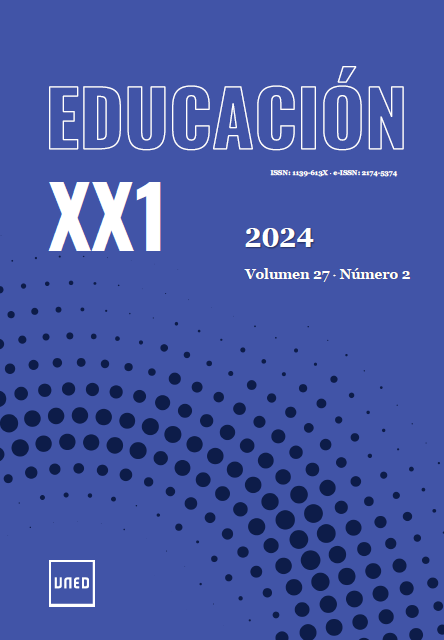Salud mental, violencia y competencias emocionales en adolescentes
DOI:
https://doi.org/10.5944/educxx1.41699Palabras clave:
competencias emocionales, salud mental, bullyingDescargas
Citas
Chamizo-Nieto, M. T., & Rey, L. (2022). Estrategias cognitivas para afrontar situaciones de acoso/ciberacoso: diferencias entre chicos y chicas. Escritos de Psicología (Internet), 15(1), 29-39.
Falcó, R., Marzo, J.C., & Piqueras, J. A. (2020). La covitalidad como factor protector ante problemas interiorizados y exteriorizados en adolescentes españoles. Psicología Conductual, 28(3), 393-413.
Falcó, R. (2023). Fortalezas psicosociales para la prevención del suicidio en adolescentes. Primera evidencia sobre el alcance del modelo de covitalidad como estrategia de actuación multinivel (Tesis doctoral inédita).
Fundación ANAR (2024). II Estudio de agresión sexual en niñas y adolescentes según su testimonio. Evolución en España (2019-2023). Recuperado de https://www.anar.org/wpcontent/uploads/2024/04/Resumen_Ejecutivo_Estudio_ANAR_Agresion_Sexual_19-23.pdf
Gómez-Ortiz, Romera, & Ortega-Ruiz (2017). Revista Interuniversitaria de Formación del Profesorado 88, 27-38.
Gong, S., Chai, X., Duan, T., Zhong, L., & Jiao, Y. (2013). Chinese teachers’ emotion regulation goals and strategies. Psychology, 4(11), 870.
Jolliffe, D., & Farrington, D. P. (2011). Is low empathy related to bullying after controlling for individual and social background variables? Journal of adolescence, 34(1), 59-71.
Kokkinos, C. M., & Kipritsi, E. (2012). The relationship between bullying, victimization, trait emotional intelligence, self-efficacy and empathy among preadolescents. Social psychology of education, 15, 41-58.
Lea, R. G., Qualter, P., Davis, S. K., Pérez-González, J. C., & Bangee, M. (2018). Trait emotional intelligence and attentional bias for positive emotion: An eye tracking study. Personality and Individual Differences, 128, 88-93.
Mayer, J.D., & Salovey, P. (1997). What is emotional intelligence? In P. Salovey & D. J. Sluyter (Eds.), Emotional Development and Emotional Intelligence: Educational Implications. New York: Basic Books, pp. 3-27.
Ortuño-Sierra, J., Fonseca-Pedrero, E., Sastre i Riba, S. & Muñiz, J. (2017). Patterns of behavioral and emotional difficulties through adolescence: the influence of prosocial skills. Anales de Psicología, 33, 48-56
Pascual, A., Conejero, S., & Etxebarria, I. (2016). Coping strategies and emotion regulation in adolescents: Adequacy and gender differences. Ansiedad y Estrés, 22(1), 1-4.
Pena, M., & Losada, L. (2017). Test anxiety in Spanish adolescents: Examining the role of emotional attention, and ruminative self-focus and regulation. Frontiers in psychology, 8, 286242.
Priego-Ojeda, M., López-Cassá, È, Pérez-Escoda, N., & Filella-Guio, G. (2024). Construcción y validación de la escala de Desarrollo emocional en Educación Primaria Inicial (EDEEPI-28). Educación XX1, 27 (2), xx-xx. https://doi.org/10.5944/educxx1.38358
Quintana-Orts, C., Rey, L., & Neto, F. (2021). Psychosocial Intervention, 30(2), 67-74.
Rey, L., Quintana-Orts, C., Mérida-López, S., & Extremera, N. (2018). Emotional intelligence and peer cybervictimisation in adolescents: Gender as moderator. Comunicar, 56, 09-18. https://doi.org/10.3916/C56-2018-01
Roos, S., Hodges, Peets, K., & Salmivalli, C. (2016). Anger and effortful control moderate aggressogenic thought–behaviour associations. Cognition and emotion, 30(5), 1008-1016.
Ros-Morente, A., Gomis, R., Priego, M., & Filella, G. (2024). Análisis de la relación e intervención entre las Competencias emocionales y la violencia. El papel de la ansiedad. Educación XX1, 27(2), xx-xx. https://doi.org/10.5944/educxx1.35828
Descargas
Publicado
Cómo citar
Número
Sección
Licencia
Derechos de autor 2024 Mario Pena Garrido

Esta obra está bajo una licencia internacional Creative Commons Atribución-NoComercial 4.0.
La revista Educación XX1 se publica bajo licencia Creative Commons Reconocimiento-NoComerciaL 4.0 (CC BY-NC 4.0). Se permite la generación de obras derivadas siempre que no se haga un uso comercial. Tampoco se puede utilizar la obra original con finalidades comerciales.








